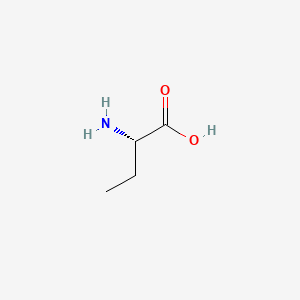| MeSH term | MeSH ID | Detail |
|---|---|---|
| Alcoholism | D000437 | 27 associated lipids |
| Diabetes Mellitus | D003920 | 90 associated lipids |
| Glioma | D005910 | 112 associated lipids |
| Liver Diseases, Alcoholic | D008108 | 13 associated lipids |
| Alcohol-Induced Disorders | D020751 | 1 associated lipids |
L-2-aminobutyric acid
L-2-aminobutyric acid is a lipid of Fatty Acyls (FA) class. The involved functions are known as Analyte, Noise and drug catabolism. The associated genes with L-2-aminobutyric acid are butyrine.
Cross Reference
Introduction
To understand associated biological information of L-2-aminobutyric acid, we collected biological information of abnormalities, associated pathways, cellular/molecular locations, biological functions, related genes/proteins, lipids and common seen animal/experimental models with organized paragraphs from literatures.
What diseases are associated with L-2-aminobutyric acid?
There are no associated biomedical information in the current reference collection.
Possible diseases from mapped MeSH terms on references
We collected disease MeSH terms mapped to the references associated with L-2-aminobutyric acid
PubChem Associated disorders and diseases
What pathways are associated with L-2-aminobutyric acid
There are no associated biomedical information in the current reference collection.
PubChem Biomolecular Interactions and Pathways
Link to PubChem Biomolecular Interactions and PathwaysWhat cellular locations are associated with L-2-aminobutyric acid?
There are no associated biomedical information in the current reference collection.
What functions are associated with L-2-aminobutyric acid?
Related references are published most in these journals:
| Function | Cross reference | Weighted score | Related literatures |
|---|
What lipids are associated with L-2-aminobutyric acid?
There are no associated biomedical information in the current reference collection.
What genes are associated with L-2-aminobutyric acid?
Related references are published most in these journals:
| Gene | Cross reference | Weighted score | Related literatures |
|---|
What common seen animal models are associated with L-2-aminobutyric acid?
There are no associated biomedical information in the current reference collection.
NCBI Entrez Crosslinks
All references with L-2-aminobutyric acid
Download all related citations| Authors | Title | Published | Journal | PubMed Link |
|---|---|---|---|---|
| Song J et al. | NMR solution structure of a two-disulfide derivative of charybdotoxin: structural evidence for conservation of scorpion toxin alpha/beta motif and its hydrophobic side chain packing. | 1997 | Biochemistry | pmid:9092804 |
| Zhao J et al. | Induction of Arabidopsis tryptophan pathway enzymes and camalexin by amino acid starvation, oxidative stress, and an abiotic elicitor. | 1998 | Plant Cell | pmid:9501110 |
| Oishi M et al. | Effectiveness of traditional Chinese medicine in Alzheimer disease. | 1998 | Alzheimer Dis Assoc Disord | pmid:9772030 |
| Chinchilla D et al. | Amino acid substitutions in the C-terminal regulatory domain disrupt allosteric effector binding to biosynthetic threonine deaminase from Escherichia coli. | 1998 | J. Biol. Chem. | pmid:9722552 |
| Oishi M et al. | [Regional cerebral blood flow and cerebrospinal fluid amino acid analysis in elderly dementia]. | 1998 | No To Shinkei | pmid:9866128 |
| Darling PB et al. | Threonine dehydrogenase is a minor degradative pathway of threonine catabolism in adult humans. | 2000 | Am. J. Physiol. Endocrinol. Metab. | pmid:10780944 |
| Keating TA et al. | Expression, purification, and characterization of HMWP2, a 229 kDa, six domain protein subunit of Yersiniabactin synthetase. | 2000 | Biochemistry | pmid:10769129 |
| Nomanbhoy TK and Schimmel PR | Misactivated amino acids translocate at similar rates across surface of a tRNA synthetase. | 2000 | Proc. Natl. Acad. Sci. U.S.A. | pmid:10792042 |
| Keating TA et al. | Selectivity of the yersiniabactin synthetase adenylation domain in the two-step process of amino acid activation and transfer to a holo-carrier protein domain. | 2000 | Biochemistry | pmid:10694396 |
| Or-Rashid MM et al. | Biosynthesis of threonine from homoserine by mixed rumen microorganisms: an in vitro study. | 2001 | Curr. Microbiol. | pmid:11136125 |
